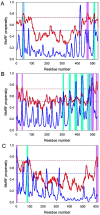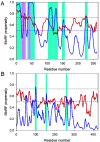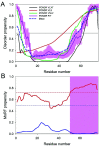Understanding the interactability of chikungunya virus proteins via molecular recognition feature analysis
- PMID: 35539973
- PMCID: PMC9083250
- DOI: 10.1039/c8ra04760j
Understanding the interactability of chikungunya virus proteins via molecular recognition feature analysis
Abstract
The chikungunya virus (CHIKV) is an alphavirus that has an enveloped icosahedral capsid and is transmitted by Aedes sp. mosquitos. It contains four non-structural proteins, namely nsP1, nsP2, nsP3, and nsP4, encoded at the 5' end of the genome, and five structural proteins encoded at the 3' end of the genome, including three glycosylated proteins, namely E1, E2, E3, a small 64 amino-acids glycoprotein 6K, and one non-glycosylated nucleocapsid protein C. The surface of this positive-stranded RNA alphavirus is covered with 80 trimeric glycoprotein spikes, which facilitate viral access into the host cell, with each consisting of three copies of E1-E2 heterodimers. The proper folding of p62, which is the precursor of E2, and formation of the E1-p62 heterodimers are controlled by E3, which is therefore essential for producing mature spikes on the alphavirus surface. Finally, 6K, a small 64 amino-acids glycoprotein, assists in the translocation of structural polyproteins to the endoplasmic reticulum and in the cleavage of p62 into mature structural proteins E2. The CHIKV proteins have been shown to contain variable levels of intrinsic disorder, often containing intrinsically disordered protein regions (IDPRs). IDPRs can interact with many unrelated partners, and these interactions are frequently accompanied by a transition from a disordered to ordered state. The corresponding sub-regions of IDPRs are acknowledged as molecular recognition features (MoRFs). Although the existence of IDPRs in CHIKV proteome has been analyzed, the prevalence of disorder-based protein-protein interactions (i.e. MoRF) in this virus have not been evaluated as of yet. To fill this gap, in our study, we utilized several computational methods to identify the MoRFs regions in CHIKV proteins. These computational tools included ANCHOR, DISOPRED3, MoRFpred and MoRFchibi_web server. These analyses revealed the presence of numerous MoRF regions in all the CHIKV proteins. In future, the results of this study could be used to identify the nature of chikungunya virus pathogenesis and might be helpful in designing drugs against this virus.
This journal is © The Royal Society of Chemistry.
Conflict of interest statement
There are no conflicts to declare.
Figures




Similar articles
-
Molecular Recognition Features in Zika Virus Proteome.J Mol Biol. 2018 Aug 3;430(16):2372-2388. doi: 10.1016/j.jmb.2017.10.018. Epub 2017 Nov 7. J Mol Biol. 2018. PMID: 29080786
-
Phosphorylation Sites in the Hypervariable Domain in Chikungunya Virus nsP3 Are Crucial for Viral Replication.J Virol. 2021 Apr 12;95(9):e02276-20. doi: 10.1128/JVI.02276-20. Print 2021 Apr 12. J Virol. 2021. PMID: 33568506 Free PMC article.
-
Functional processing and secretion of Chikungunya virus E1 and E2 glycoproteins in insect cells.Virol J. 2011 Jul 15;8:353. doi: 10.1186/1743-422X-8-353. Virol J. 2011. PMID: 21762510 Free PMC article.
-
Immunological impact of cytokines on the chikungunya virus pathophysiology: A literature narrative review.Rev Med Virol. 2023 Jul;33(4):e2441. doi: 10.1002/rmv.2441. Epub 2023 Apr 5. Rev Med Virol. 2023. PMID: 37021332 Review.
-
Targeting Chikungunya Virus Entry: Alternatives for New Inhibitors in Drug Discovery.Curr Med Chem. 2022;29(4):612-634. doi: 10.2174/0929867328666210623165005. Curr Med Chem. 2022. PMID: 34165405 Review.
Cited by
-
Structure Characterization of a Disordered Peptide Using In-Droplet Hydrogen/Deuterium Exchange Mass Spectrometry and Molecular Dynamics.ACS Phys Chem Au. 2024 Nov 13;5(1):17-29. doi: 10.1021/acsphyschemau.4c00048. eCollection 2025 Jan 22. ACS Phys Chem Au. 2024. PMID: 39867440 Free PMC article.
-
Spread of a Novel Indian Ocean Lineage Carrying E1-K211E/E2-V264A of Chikungunya Virus East/Central/South African Genotype across the Indian Subcontinent, Southeast Asia, and Eastern Africa.Microorganisms. 2022 Feb 3;10(2):354. doi: 10.3390/microorganisms10020354. Microorganisms. 2022. PMID: 35208808 Free PMC article.
-
Targeting the nsp2 Cysteine Protease of Chikungunya Virus Using FDA Approved Library and Selected Cysteine Protease Inhibitors.Pathogens. 2019 Aug 15;8(3):128. doi: 10.3390/pathogens8030128. Pathogens. 2019. PMID: 31443266 Free PMC article.
-
Chikungunya and Zika Viruses: Co-Circulation and the Interplay between Viral Proteins and Host Factors.Pathogens. 2021 Apr 9;10(4):448. doi: 10.3390/pathogens10040448. Pathogens. 2021. PMID: 33918691 Free PMC article. Review.
-
Mutations in membrane-fusion subunit of spike glycoprotein play crucial role in the recent outbreak of COVID-19.J Med Virol. 2021 May;93(5):2790-2798. doi: 10.1002/jmv.26598. Epub 2021 Feb 23. J Med Virol. 2021. PMID: 33090493 Free PMC article.
References
-
- Schuffenecker I. Iteman I. Michault A. Murri S. Frangeul L. Vaney M. C. Lavenir R. Pardigon N. Reynes J. M. Pettinelli F. Biscornet L. Diancourt L. Michel S. Duquerroy S. Guigon G. Frenkiel M. P. Brehin A. C. Cubito N. Despres P. Kunst F. Rey F. A. Zeller H. Brisse S. PLoS Med. 2006;3:e263. doi: 10.1371/journal.pmed.0030263. - DOI - PMC - PubMed
LinkOut - more resources
Full Text Sources
Miscellaneous

